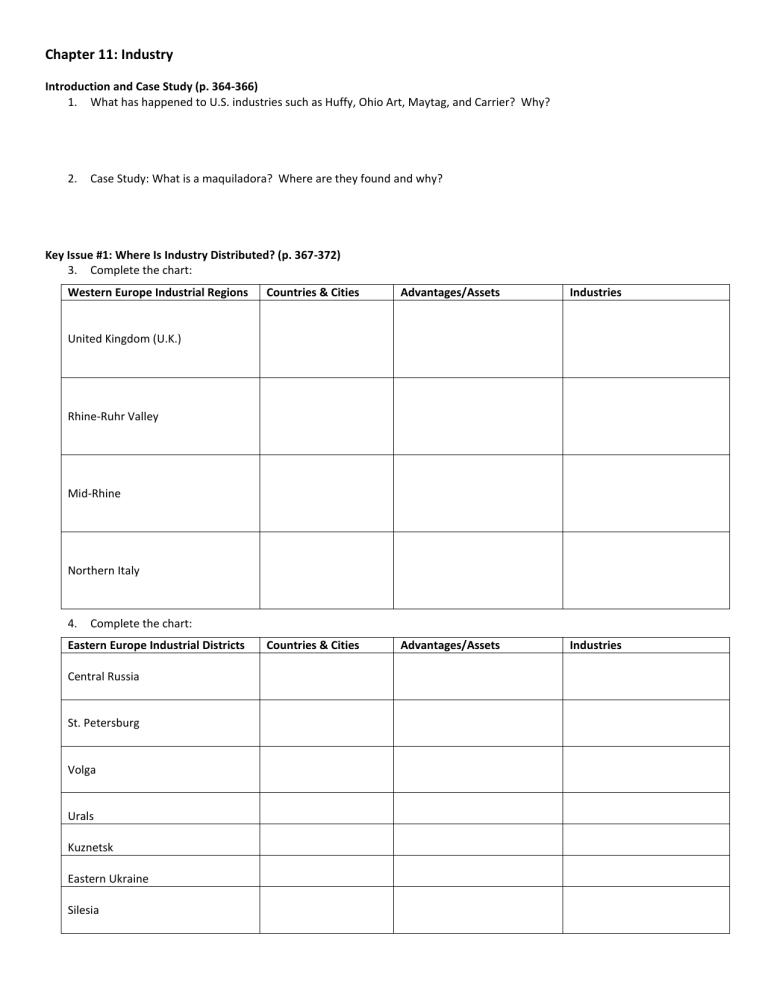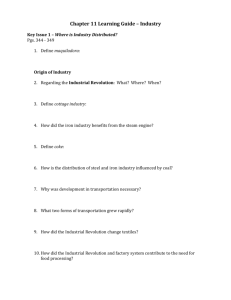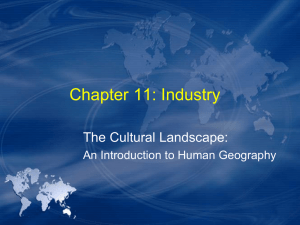Chapter 11: Industry Introduction and Case Study (p. 364

Chapter 11: Industry
Introduction and Case Study (p. 364-366)
1.
What has happened to U.S. industries such as Huffy, Ohio Art, Maytag, and Carrier? Why?
2.
Case Study: What is a maquiladora? Where are they found and why?
Key Issue #1: Where Is Industry Distributed? (p. 367-372)
3.
Complete the chart:
Western Europe Industrial Regions Countries & Cities Advantages/Assets
United Kingdom (U.K.)
Rhine-Ruhr Valley
Mid-Rhine
Northern Italy
4.
Complete the chart:
Eastern Europe Industrial Districts Countries & Cities
Central Russia
St. Petersburg
Volga
Urals
Kuznetsk
Eastern Ukraine
Silesia
Advantages/Assets
Industries
Industries
5.
Complete the chart:
North America Industrial Regions
New England
Middle Atlantic
Mohawk Valley
Pittsburgh-Lake Erie
States/Provinces & Cities Advantages/Assets Industries
Western Great Lakes
St. Lawrence Valley-Ontario
Peninsula
6.
What is the major industrial advantage of East Asia?
7.
What are Japan’s major industrial outputs? What city clusters serve as Japan’s major industrial centers?
8.
Study Figure 11-7 on p. 372. What are the major manufacturing centers of China?
Key Issue #2: Why Do Industries Have Different Distributions? (p. 372-384)
9.
Describe the 2 major cost factors for industry. Give examples of each.
10.
Why would an industry prefer to locate close to inputs?
11.
Describe the steps in copper extraction and production. Why is copper a bulk-reducing industry?
12.
How is steel different from iron? What types of products are made from iron and steel?
13.
Describe inventions and technologies that improved the steel industry.
14.
Describe where and why the U.S. steel industry began and moved to.
15.
16.
17.
Why are new steel mills and mini-mills now built near major cities?
Why would an industry choose to locate near consumers (near the market)?
Describe bulk-gaining industries AND give multiple different examples.
18.
Describe the current location of auto assembly plants in the U.S. How does this differ from historical locations? Notice
Figure 11-12.
19.
Contemporary Geographic Tools: What criteria did General Motors (GM) consider for its Saturn assembly plant in 1985?
20.
21.
22.
Where are most auto part manufacturers located? Why?
Why must perishable products locate near the market? Give examples of perishable products.
Describe the advantages and disadvantages of each of the 4 major modes of transportation—ship, rail, truck, and air.
23.
What is a break-of-bulk point? Why might industries choose to locate near that point?
24.
What are the 3 main site factors? Which one is the most important?
25.
What is a labor-intensive industry? Why is textile and apparel production an example of labor-intensive?
26.
Describe the textile spinning process. How has it changed over time?
27.
What countries are major textile spinning countries? Why?
28.
Describe the weaving process. What countries are the leaders in textile weaving?
29.
Why did the chemical and canning industries develop near textile industries?
30.
Describe the textile assembly process. What 4 main product types are assembled?
31.
Where is most textile assembly completed? Why? Notice Figure 11-16.
32.
What characteristics of land as a site factor influence industrial locations? Why is the aluminum industry interested in land site factors?
33.
Why is capital important? Why did Silicon Valley in California develop as a high-tech industrial cluster?
Key Issue #3: Where Is Industry Expanding? (p. 384-389)
34.
In relation to a city, where were most factories located historically? Why?
35.
Where do most factories locate now in relation to a city? Why has the typical location changed?
36.
What has happened to manufacturing jobs in the U.S. since the 1970s? Describe why this interregional shift has occurred.
37.
Describe the industrial advantages of the U.S. Gulf Coast and of Los Angeles, CA.
38.
Describe the interregional shift in industry in Europe. Why has this shift occurred?
39.
Describe the shift in world steel production from 1980 to 2005.
40.
Complete the chart:
New Industrial Regions
Asia
Latin America
Central Europe
Countries & Regions Advantages/Assets Industries
Key Issue #4: Why Are Location Factors Changing? (p. 389-394)
41.
What is the primary factor of attracting industries to new regions?
42.
Describe the shifts in locations of the U.S. textile industry. Why did these shifts occur?
43.
What is the new international division of labor? Why has it developed?
44.
What is outsourcing? Contrast outsourcing with the old practice of vertical integration.
45.
What 2 factors attract industries to the traditional industrial regions?
46.
Differentiate between Fordist (mass) production and post-Fordist production.
47.
Where and why do computer manufacturing and high-end clothing industries locate in the U.S.?
48.
Global Forces, Local Impacts: What factors determine where car parts are manufactured?
49.
What is just-in-time delivery? What are the advantages and disadvantages of this practice?
50.
Case Study Revisited: Discuss the advantages and disadvantages of the North American Free Trade Agreement (NAFTA).




